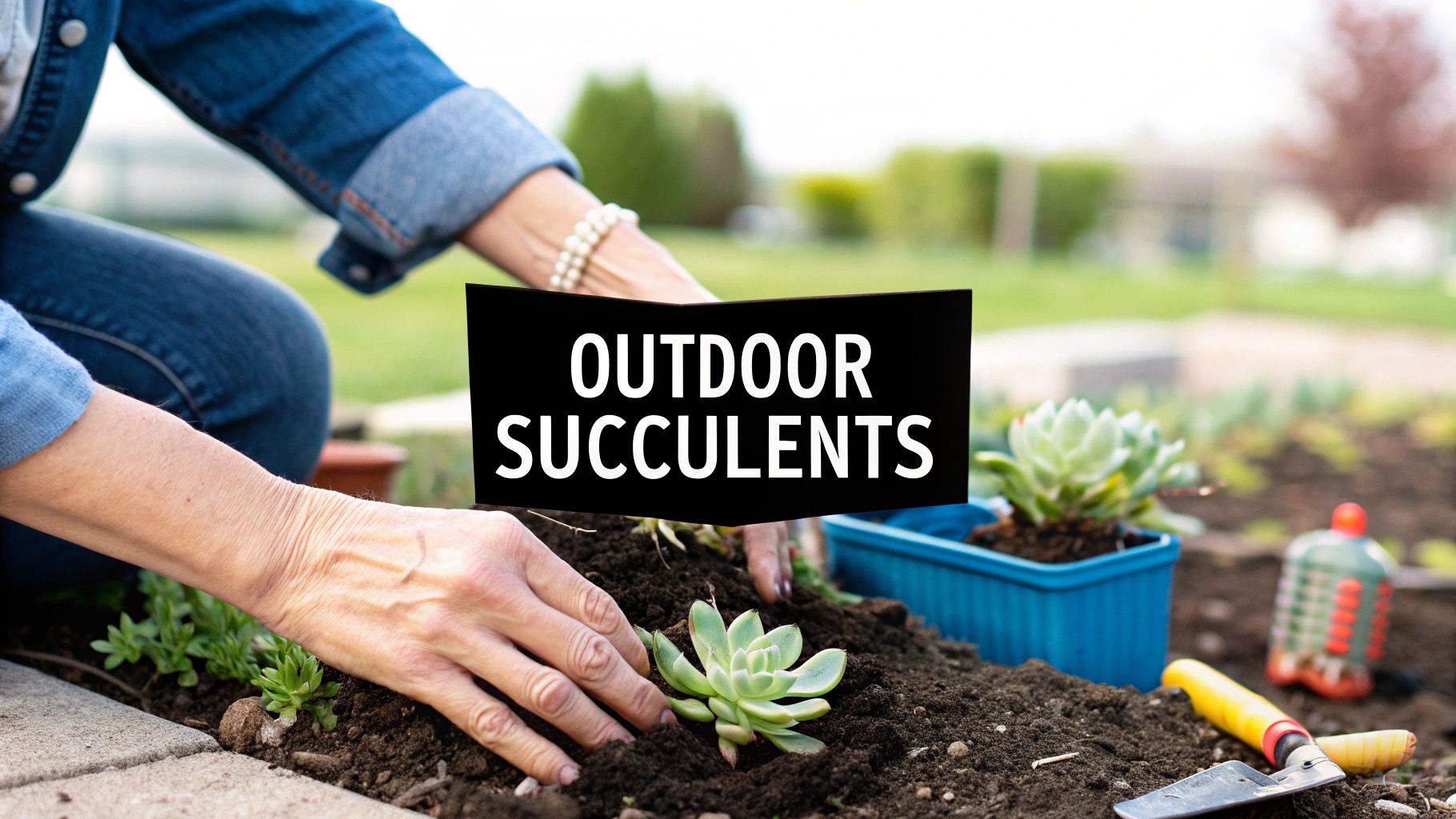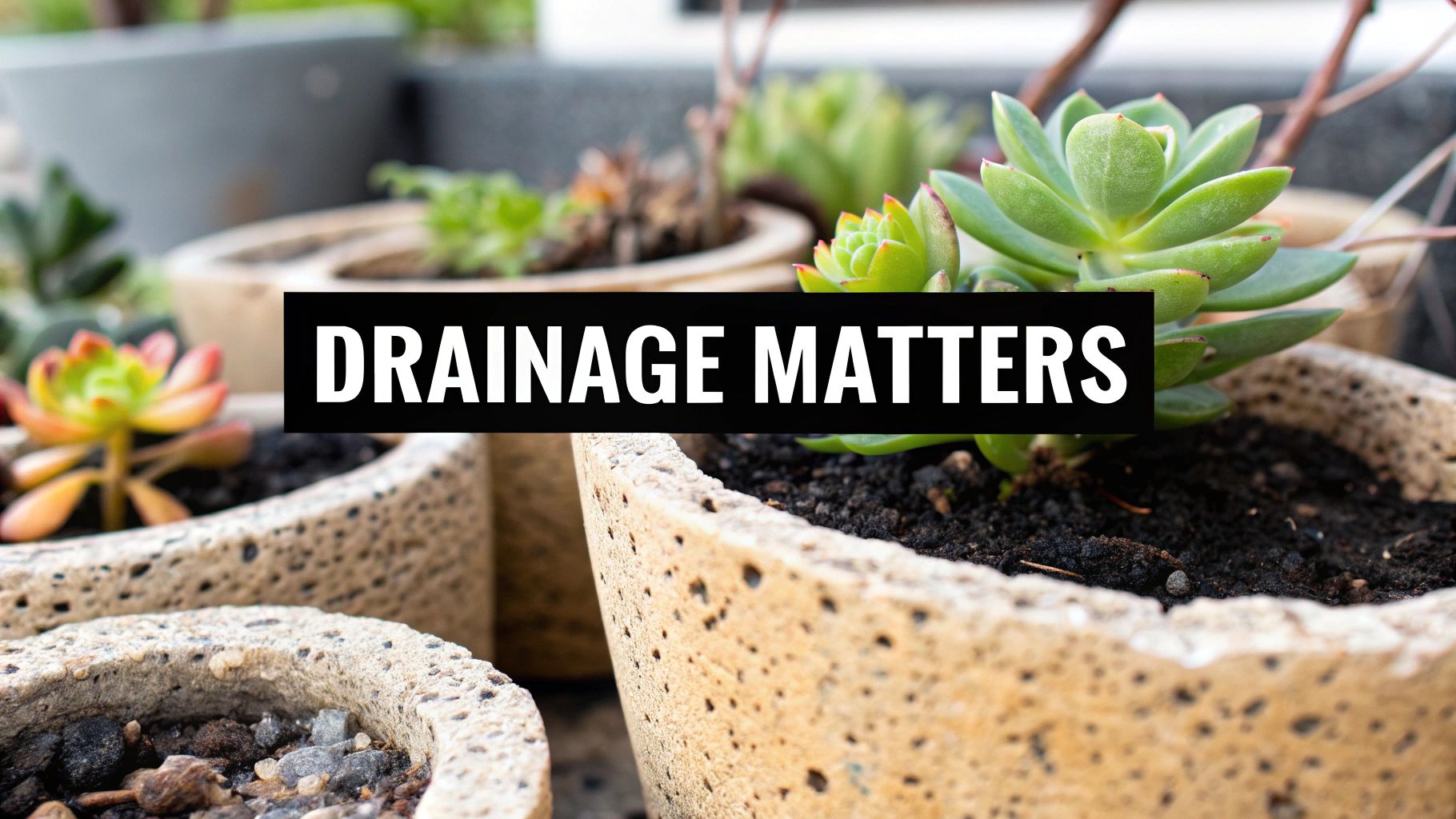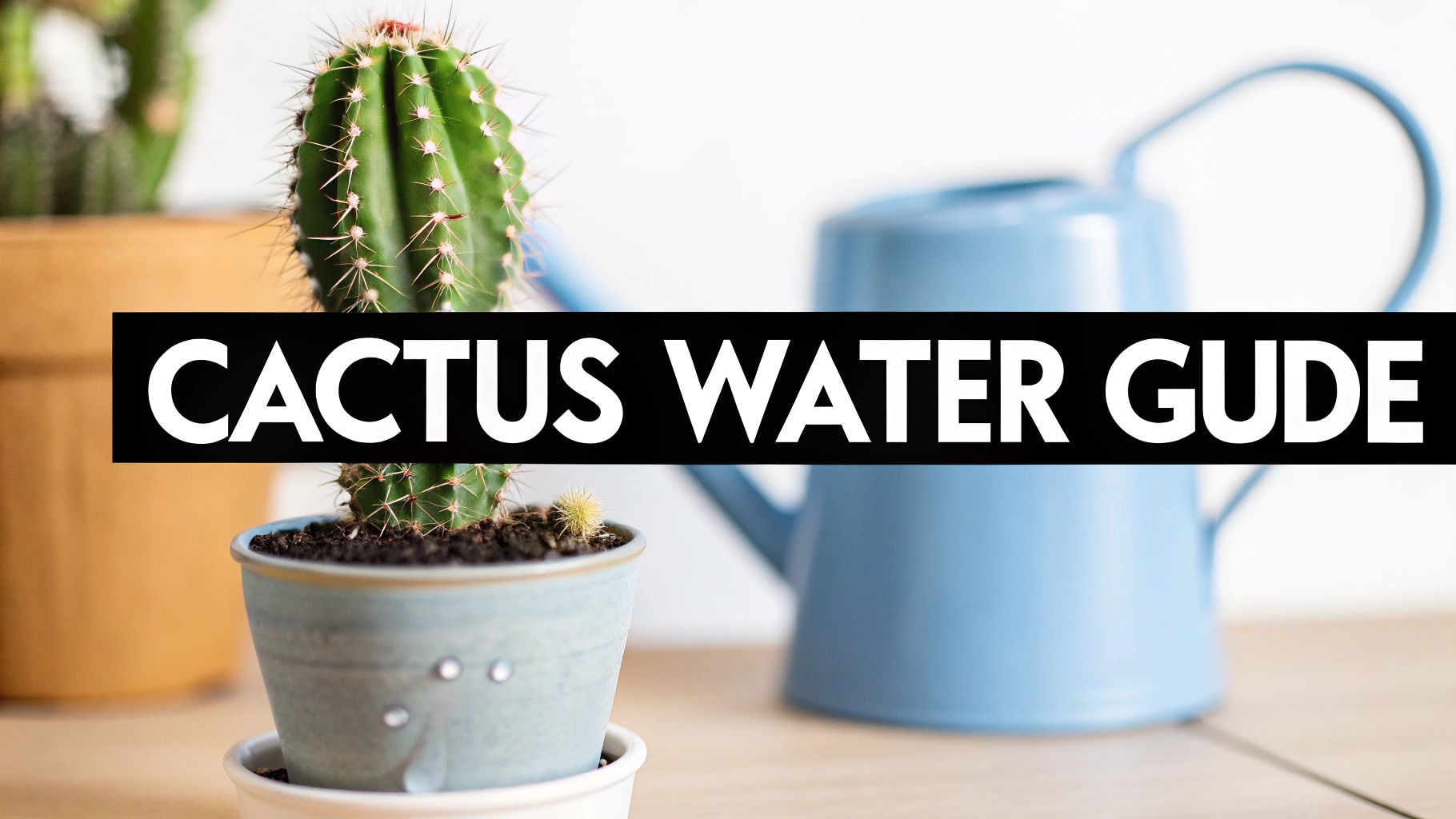Trying to find the best plants for bathroom low light? You'll have the most success with tropical plants that naturally love humidity and don't need a ton of direct sun. Think of the super-tough Snake Plant, the classic trailing Pothos, or the elegant Peace Lily. These plants are built to thrive in conditions that feel just like their native rainforest floor.
Why Your Bathroom Is a Secret Plant Paradise
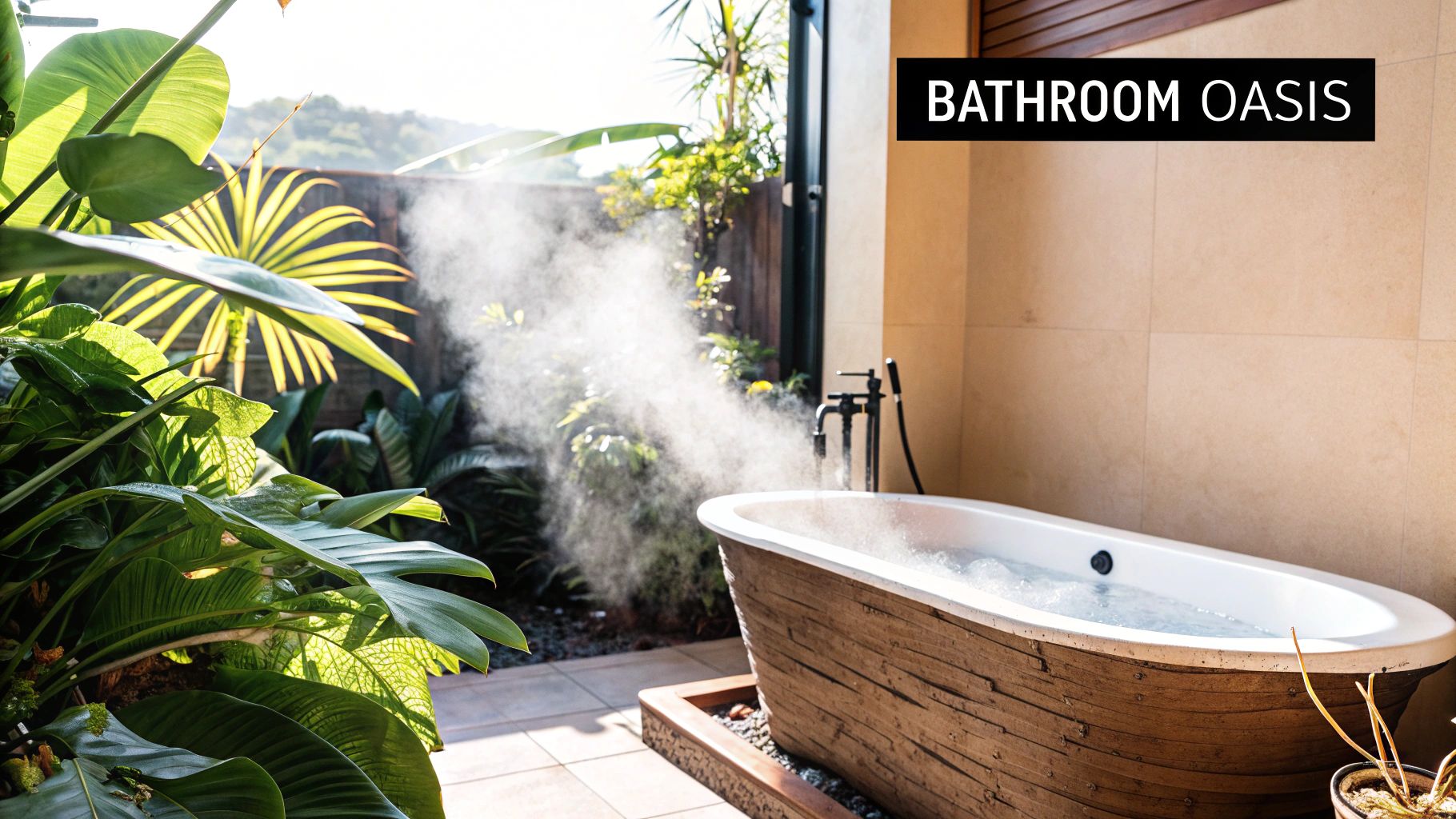
Let's debunk a myth right now: bathrooms are not plant graveyards. In fact, for the right kind of plant, your bathroom is a five-star resort. The trick isn't fighting against the environment, but leaning into what makes it unique.
Think about it. Your daily showers create a steamy, high-humidity atmosphere that many popular houseplants crave. This warm, moist air is a dead ringer for the tropical climates they come from, helping their leaves stay hydrated and preventing those sad, crispy brown tips.
The Perfect Blend of Humidity and Indirect Light
On top of the humidity, most bathrooms have smaller, often frosted, windows that provide indirect or low light. While that might sound like a death sentence for a sun-loving succulent, it’s the ideal setup for plants that grow on the forest floor. They’ve spent millennia adapting to life under a thick canopy, catching only the dappled light that filters through. Your bathroom window offers them a familiar comfort.
This isn’t just some niche trick for hardcore plant collectors, either. The hashtag '#bathroomplants' is blowing up for a reason. People are catching on to how easy it is to create a spa-like vibe by simply choosing plants that are already a perfect match for the space. You can see this trend everywhere, from home decor blogs to major publications like Gardeningetc.com.
The key is selection. Choosing a plant that naturally loves humidity and shade isn't about forcing it to adapt; it's about giving it an environment where it's already programmed to flourish.
When you match the plant to the room, you're not just hoping it survives—you're setting it up to thrive. It's a simple principle that works everywhere, which is why there's also great advice out there for picking the best indoor plants for offices, as they often face similar low-light conditions. By working with your home's natural environment, you can turn any room, especially your bathroom, into a green sanctuary.
What "Low Light" and "High Humidity" Really Mean for Your Plants
Picking the right plant for your bathroom can feel like a guessing game, but it gets a lot easier once you know why certain plants do so well there. It’s not about finding a plant that can merely tolerate the conditions; it's about finding one that's naturally built for that kind of environment.
The two big players here are low light and high humidity. Let's break down what these actually mean from a plant's perspective.
Cracking the Code on Low Light
First off, "low light" is probably the most misunderstood term in plant care. It absolutely does not mean no light. Every single plant needs some light to photosynthesize—that’s how they eat.
Think of low light as gentle, indirect sunlight. This might be the light from a north-facing window, a spot across the room from a brighter window, or even a space that relies mostly on good-quality artificial light. The plants that thrive here, including many you'll find at The Cactus Outlet, often have origins under the thick canopy of a rainforest. They’ve spent generations adapting to catch the filtered, dappled light that makes it to the forest floor.
How Plants Adapt to Dimmer Conditions
To survive in these shady spots, plants evolved some clever tricks. You'll often notice they have larger, thinner leaves. This isn't just for looks; it’s a brilliant strategy to create a bigger "solar panel" to soak up every available bit of light. It's why plants like the Peace Lily or ZZ Plant have such big, lush leaves—they are masters of light collection.
Now, add in the high humidity from your daily showers. This steamy air creates a little tropical microclimate right in your bathroom, and your plants will love you for it. They can actually absorb some moisture through their leaves, and the humid air means they lose less water through evaporation.
It's like wrapping the plant in a cozy, moist blanket. The plant doesn't have to work as hard to pull water all the way up from its roots, which is a huge help in preventing those crispy, brown leaf tips we all hate to see.
This handy visual breaks down how the specific conditions in a bathroom cater to these plant adaptations.
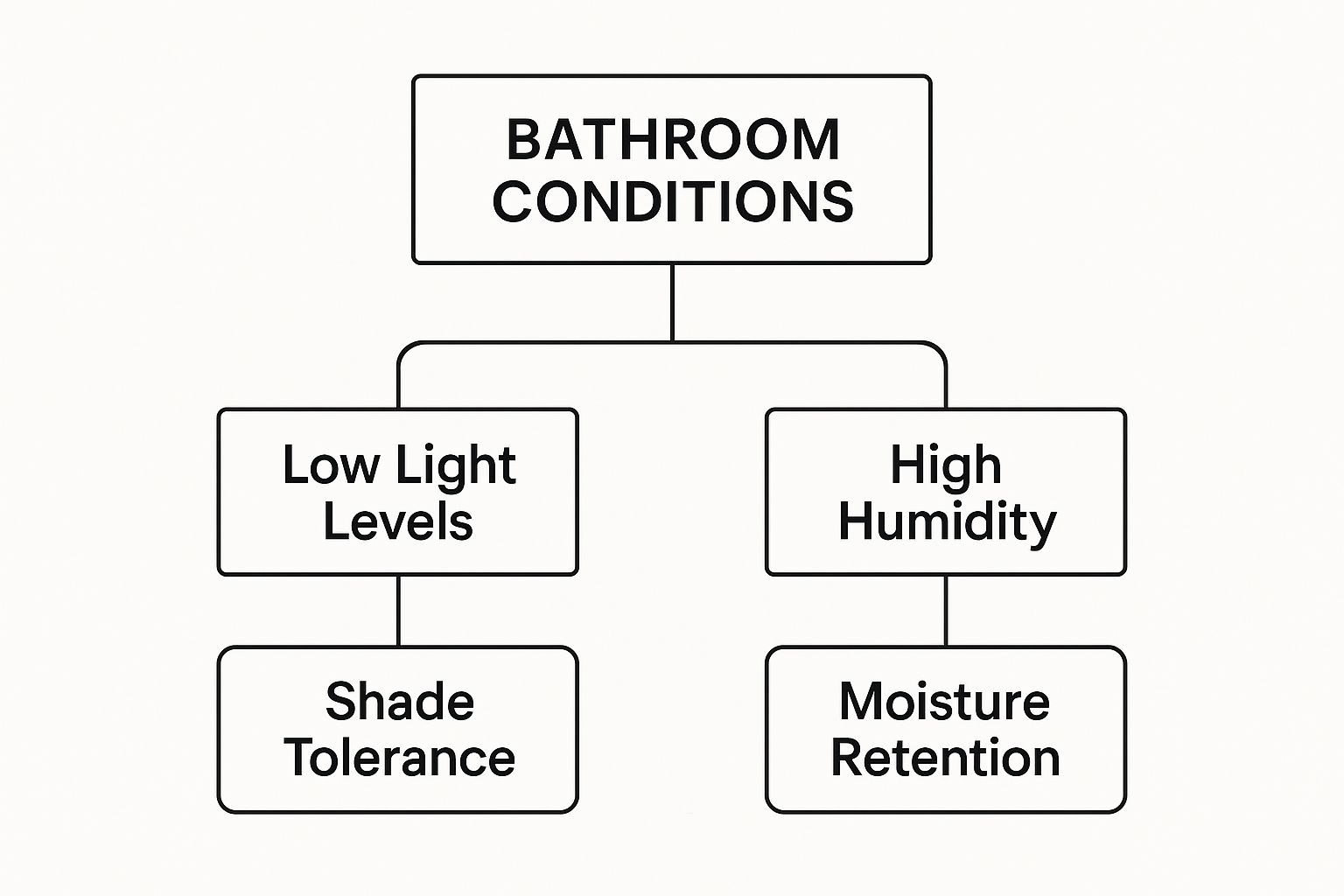
As you can see, the environment isn't something the plant has to fight against; it's a perfect match for the survival tools it already has.
The Two Sides of High Humidity
While the steamy air is a huge plus for your plants, it's worth knowing that it's the same reason for other bathroom quirks, like what causes windows to fog up. All that wonderful moisture that nourishes your greenery will condense on cooler surfaces like glass and mirrors.
For your plants, though, it's almost all upside. They'll have more vibrant leaves and won't need to be watered quite as often. The only thing you need to watch out for is soggy soil. With so much moisture in the air, it’s crucial to have pots with good drainage to avoid root rot. Nail that balance, and you've got yourself a thriving, self-sustaining green sanctuary.
The Top 7 Plants That Thrive in Low Light Bathrooms
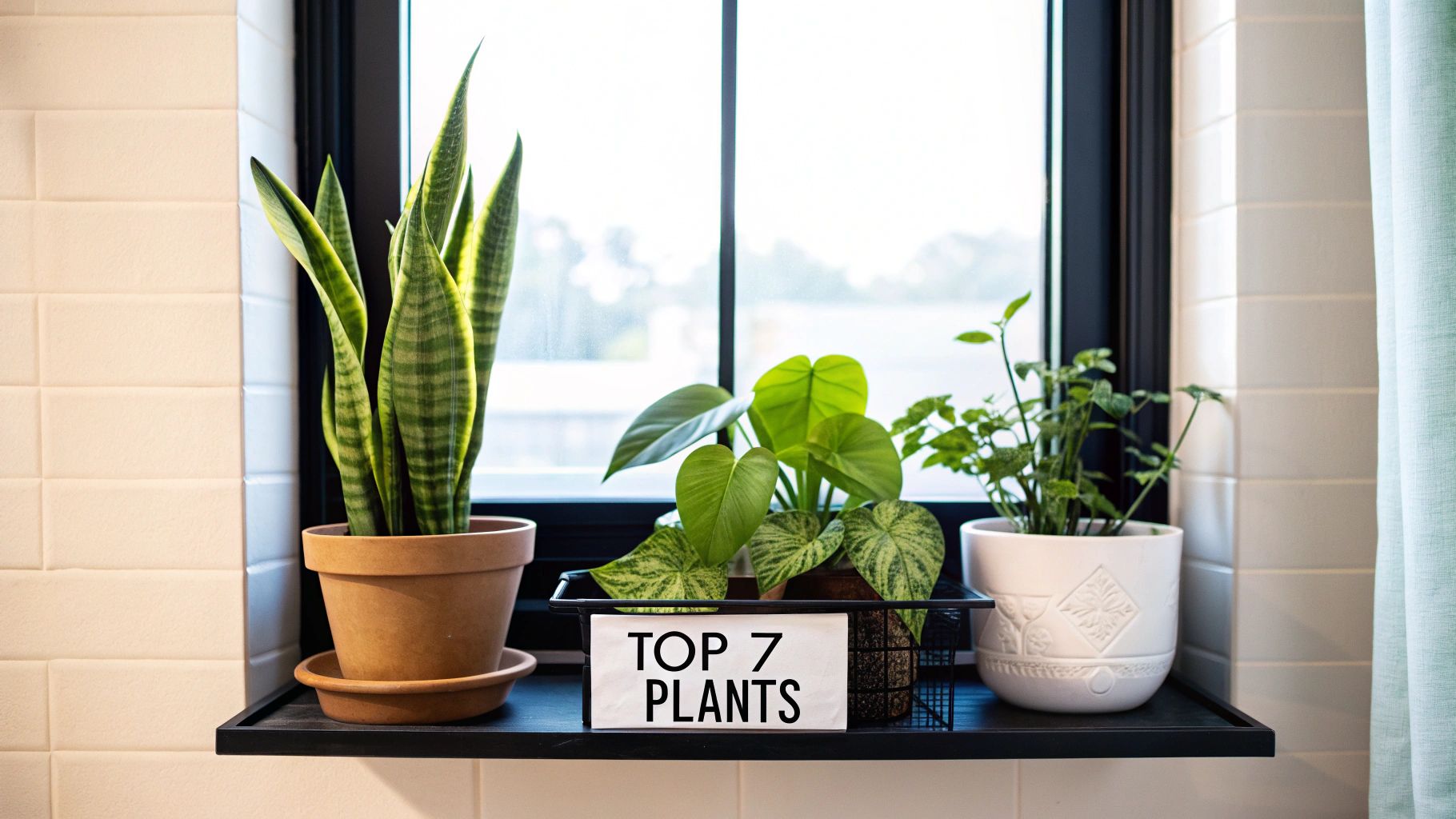
Alright, you know why the bathroom is a secret plant paradise. Now, let's get to the fun part—meeting the plants that actually thrive there. I’ve put together a list of some of the most resilient and beautiful plants that will absolutely love the steam and dimmer light of your bathroom.
Think of these as the tried-and-true champions of bathroom greenery. We'll go through what makes each one special and how to care for them, so you can pick the perfect green companion for your space.
1. Snake Plant (Dracaena trifasciata)
The Snake Plant has a well-earned reputation for being nearly indestructible. With its stiff, sword-like leaves shooting straight up, it brings a clean, modern vibe to any corner. It’s a top-tier choice for bathroom low light because it’s incredibly forgiving and doesn't demand much attention.
On top of its good looks, this plant is a fantastic air purifier. Its leaves store water, so the biggest mistake you can make is giving it too much love—especially in an already humid room.
- Watering: Wait for the soil to dry out completely. This usually means watering just every 3-4 weeks.
- Light Needs: It's happiest in indirect light but will put up with very low light like a champ.
- Pro Tip: If you're just starting your plant journey, this is the one. Seriously, it's tough to kill.
2. Pothos (Epipremnum aureum)
There’s a reason Pothos is such a classic. Its gorgeous, heart-shaped leaves and trailing vines look incredible cascading down a high shelf or from a hanging basket. It instantly adds a bit of jungle drama to a room. Pothos is also great at telling you what it needs—if the leaves look a little limp, it’s probably thirsty.
Pothos is one of the most recognized plants for low-light bathrooms simply because it’s so adaptable. These plants can get by on as little as 10-15 foot-candles of light, a common scenario in windowless bathrooms. You’ll notice they adapt by growing longer stems between the leaves, stretching to catch every available ray of light.
3. ZZ Plant (Zamioculcas zamiifolia)
If you've ever seen a plant with such perfect, glossy leaves that it looks fake, you were probably looking at a ZZ Plant. This is the definition of a low-maintenance plant. It shrugs off drought, low light, and low humidity, making it the perfect pick for busy people or anyone who occasionally forgets to water.
The ZZ Plant has underground rhizomes that store water, much like a camel's hump. This adaptation allows it to go for long periods without a drink, making it a perfect set-it-and-forget-it option for your bathroom.
This one is also a slow grower, so the plant you bring home will stay that size for quite a while. That makes it perfect for styling a particular spot without worrying it will outgrow the space anytime soon.
4. Spider Plant (Chlorophytum comosum)
The Spider Plant is just a cheerful, easygoing choice. It’s famous for its arching leaves and the little "spiderettes" that hang down from the mother plant. The best part? You can easily snip off those baby plants and pot them to make more.
They like their soil to stay fairly moist but will forgive you if they dry out now and then. Plus, they're non-toxic, so they're a safe bet for homes with curious pets.
5. Peace Lily (Spathiphyllum)
For a touch of pure elegance, you can't beat the Peace Lily. Its deep green leaves and iconic white spathes (the part people mistake for a flower) bring a calm, spa-like feeling to a bathroom. It absolutely loves high humidity and prefers its soil to stay consistently moist.
- Watering: Give it a drink when the top inch of soil feels dry. It will famously droop to let you know it's thirsty.
- Light Needs: It does best in bright, indirect light but handles medium to low light just fine.
- Common Issue: If you see brown leaf tips, your tap water might have too many minerals. Try using filtered or distilled water instead.
Choosing the right plant can feel overwhelming, so here’s a quick-glance table to help you compare our top picks.
A Quick Comparison of Top Bathroom Plants
Use this table to easily compare our recommended plants based on light needs, humidity preference, and care difficulty to find the perfect match for your bathroom.
| Plant Name | Light Tolerance | Humidity Preference | Watering Needs | Care Level |
|---|---|---|---|---|
| Snake Plant | Very Low to Bright, Indirect | Low to High | Infrequent (every 3-4 weeks) | Very Easy |
| Pothos | Low to Bright, Indirect | Moderate to High | When top inch is dry | Very Easy |
| ZZ Plant | Very Low to Bright, Indirect | Low to High | Very Infrequent (monthly) | Very Easy |
| Spider Plant | Low to Bright, Indirect | Moderate to High | Keep evenly moist | Easy |
| Peace Lily | Medium to Low | High | Keep soil moist | Easy |
Hopefully, this makes it easier to see which plant's personality best fits your home and lifestyle.
While we’ve covered some of the best, there are plenty of other tough plants out there. If you're looking to expand your collection, you can Discover more low-maintenance indoor plants suitable for various light conditions to find even more green friends. And for those drawn to hardy, low-water options, don't miss our guide on the easiest succulents to grow indoors.
Surprising Survivors: Cacti and Succulents for Bathrooms
When you think of a cactus, you probably imagine a sun-scorched desert, not a steamy, low-light bathroom. It's a common belief that these hardy plants need constant, blazing sun to live. But what if I told you that some of the best plants for low-light bathroom conditions are actually jungle cacti?
These aren't your typical prickly desert dwellers. Not at all. They come from the canopies of tropical rainforests, where they've learned to live on trees and rocks, soaking up high humidity and whatever filtered sunlight trickles down. Think of them as the rebels of the succulent world—they traded desert grit for jungle mist.
This unique background is exactly what makes them a perfect, if surprising, fit for your bathroom. They’re naturally adapted to thrive in the very conditions that would kill their desert cousins: consistent moisture in the air and indirect light.
Meet the Jungle Dwellers
Two fantastic examples of these bathroom-friendly succulents are the Christmas Cactus (Schlumbergera) and the Mistletoe Cactus (Rhipsalis). Unlike cacti rooted in the ground, these plants are epiphytes. This just means they naturally grow on other plants, like trees, without being parasitic. Their roots are mainly for hanging on, while they pull moisture and nutrients right from the air and rain.
Their epiphytic nature is their secret weapon for surviving, and even thriving, in a bathroom.
-
Christmas Cactus (Schlumbergera): Famous for its gorgeous, cascading blooms around the holidays, this cactus absolutely loves the ambient humidity from your shower. Its flat, segmented stems are built to catch moisture and do just fine in dappled light.
-
Mistletoe Cactus (Rhipsalis): With its delicate, trailing stems that look like a green waterfall, this plant is a showstopper in a hanging basket. It's one of the few cacti found naturally outside the Americas and is perfectly at home in a humid, shady corner.
The single most important thing for these tropical succulents is excellent drainage. While they adore humidity in the air, their roots absolutely cannot stand to be waterlogged. A chunky, well-draining potting mix is non-negotiable to prevent root rot.
Globally, other tropical plants have also become bathroom favorites for the same reason. For instance, Calathea and Philodendron do best in humidity levels that often top 70%, which is a near-perfect match for their native rainforest homes. You can learn more about how different plants adapt from the Plants and Flowers Foundation Holland.
By choosing these surprising survivors, you can add the unique beauty of cacti and succulents to your home without needing a south-facing window. For more ideas, check out our guide on the best cactus for indoors to find the perfect plant for any room.
Essential Care Tips for a Thriving Bathroom Jungle
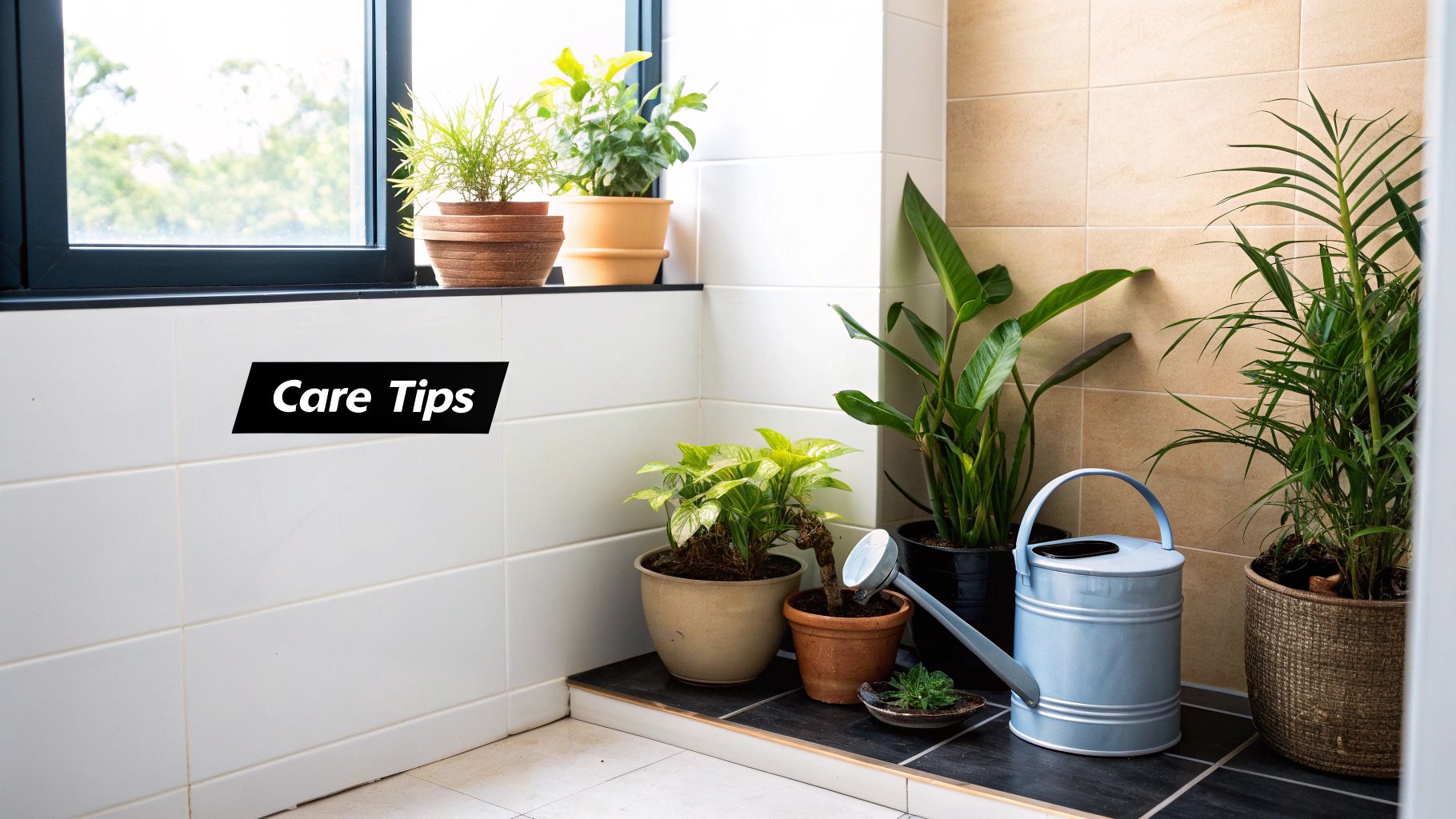
Alright, you’ve picked out the perfect plant. That's the first step. But the real reward comes from helping it flourish in its new home. Bathrooms are a different world for plants—they’re warm, steamy, and often pretty dim. This means you’ll need to adjust your care routine a bit to keep your new green friend happy.
The biggest mistake I see people make is with watering. Because of all the humidity from hot showers, the soil in your pots just doesn't dry out as fast as it would in your living room. Overwatering is a real risk here, and it's the number one cause of root rot, a death sentence for most houseplants.
Mastering the Watering Game
Think of it this way: the shower steam takes care of keeping the leaves happy, so your job is to focus on the roots. Before you even think about grabbing the watering can, check the soil first. The best tool you have is your finger.
Stick your finger about an inch into the soil. If you feel any dampness at all, put the can down and walk away. It’s always safer to let the plant get a little thirsty than to drown it, especially in a humid environment.
Pro Tip: Ditch the Schedule
Don't water your plants on a strict schedule, like every Sunday morning. Instead, let the plant and the soil tell you what they need. Check them weekly, but only water when that top inch of soil is completely dry to the touch.
Your secret weapon against overwatering is proper drainage. Every single pot needs to have holes in the bottom, no exceptions. If water can't escape, it just sits there, creating a swamp that will suffocate the roots. Got a gorgeous decorative pot with no holes? No problem. Just use it as a "cachepot" and slip a basic plastic nursery pot (with holes!) inside.
Boosting Health with Light and Air
Even plants that tolerate low light still need some light to live. To keep your plant from getting lopsided and stretching desperately towards the window, give it a simple quarter turn every week. This little trick ensures all sides get their fair share of sun, encouraging a much fuller, more even shape.
Finally, let’s talk about fresh air. Stagnant, humid air is a perfect breeding ground for mildew and other nasty fungal problems. Keeping the air moving is easy and makes a huge difference.
- Turn on the Fan: Run your bathroom's exhaust fan for 15-20 minutes after you shower. This whisks away the thickest steam and keeps things fresh.
- Keep the Leaves Clean: Dust builds up on leaves and basically acts like sunscreen, blocking the light. Every few weeks, take a damp cloth and gently wipe them down. It’s like clearing the dust off a solar panel—it just works better.
Nailing these simple habits will transform your bathroom from a potential plant graveyard into a thriving, green oasis.
Got Questions About Bathroom Plants? We’ve Got Answers.
Even after you've picked the perfect plant, a few questions are bound to pop up. Think of this as your go-to guide for those "what if" moments that happen once your new green friend is settled in. We'll tackle some of the most common puzzles plant parents face.
We're covering everything from those tricky windowless bathrooms to keeping your pets safe. The goal here is to give you clear, no-fuss answers so you can build a thriving bathroom garden with confidence.
Can I Really Keep a Plant in a Bathroom with No Windows?
Yes, you absolutely can, but it’s not a "set it and forget it" situation. While some plants are incredibly tough, no plant can survive in total darkness. They all need light to photosynthesize and make their food.
For a windowless room, you'll need to bring in the light yourself. A full-spectrum grow light running for about 8-10 hours a day will do the trick.
Another clever workaround is what I call the "swapping method." Get two similar low-light plants, maybe a couple of beautiful Pothos. Keep one in the dark bathroom and the other in a room that gets good natural light. Every two weeks or so, just swap their spots. This little rotation gives each plant a chance to recharge and stay healthy.
What Are the Best Small Plants for a Tiny Bathroom?
When space is tight, you have to think smart. You don't need a massive plant to make a big impact. A Bird's Nest Fern is a fantastic choice; its wavy leaves grow in a tidy little rosette, so it grows up more than out.
A few other great options for small bathrooms include:
- Small Pothos or Heartleaf Philodendron: These are perfect for perching on a high shelf or the corner of the vanity. Their vines will trail down gracefully, adding a beautiful cascade of green without cluttering up your counter.
- Air Plants (Tillandsia): These are the ultimate minimalists. Since they don't even need soil, you can get really creative. Mount them on the wall in a cool holder or just place them in a tiny decorative dish.
Which Low-Light Bathroom Plants Are Safe for Pets?
For those of us with curious cats or dogs, keeping them safe is non-negotiable. Luckily, you don't have to sacrifice style for safety. There are plenty of gorgeous, non-toxic plants that will love your bathroom's humidity.
Some of the best pet-safe choices that thrive in bathroom conditions are the Spider Plant, many types of Calathea (like the Prayer Plant), and the classic Bird's Nest Fern.
On the flip side, you'll want to be careful with some common low-light plants. Pothos, Peace Lilies, and Snake Plants are toxic if nibbled on by pets. If you have your heart set on one, make absolutely sure it's placed somewhere completely out of their reach.
How Do I Stop Mold from Growing on My Plant's Soil?
In a humid room, good air circulation is your secret weapon against mold. The idea is to keep damp, stagnant air from sitting on the soil surface for too long.
Make it a habit to run your bathroom’s exhaust fan for about 20 minutes after you shower. It’s a simple step that makes a huge difference in cutting down that lingering moisture.
Also, make sure your pots have drainage holes and resist the urge to overwater. Let the top inch of soil dry out completely before giving your plant another drink. If you ever spot a little white fuzz, you can just scrape it off. For a natural fix, a light sprinkle of ground cinnamon on the soil works as a great fungicide.
Ready to turn your bathroom into the green sanctuary you've been dreaming of? The Cactus Outlet has a fantastic collection of jungle cacti and other unique succulents that, believe it or not, are perfect for handling the humidity and lower light of a bathroom.
Explore our collection of bathroom-friendly plants at The Cactus Outlet


